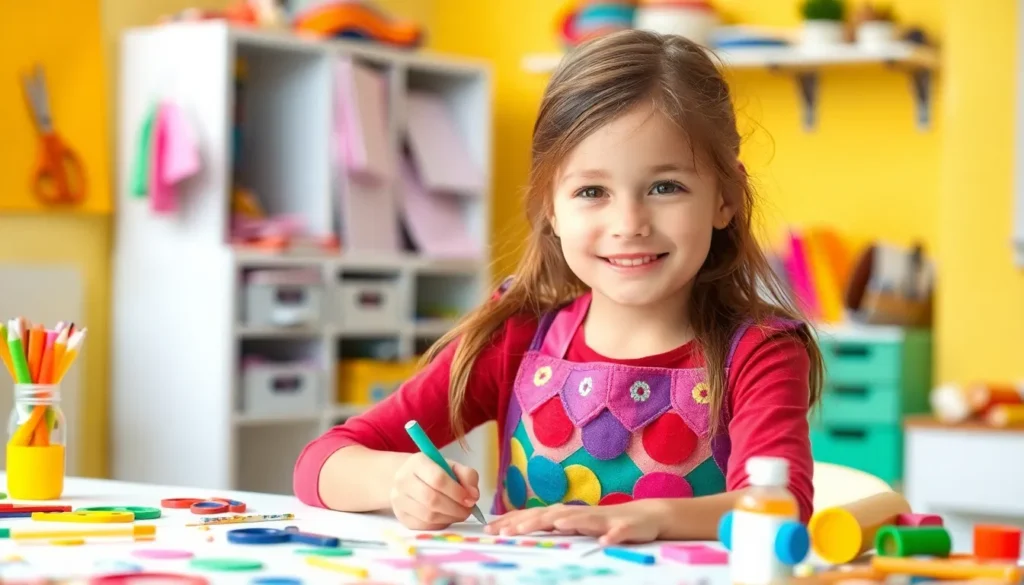Crafting isn’t just for adults with fancy Pinterest boards; it’s a magical world where kids can unleash their creativity and maybe even make a little mess along the way. Imagine tiny hands covered in paint and glitter, giggles echoing through the house as they transform everyday items into masterpieces. DIY crafts for kids offer more than just entertainment; they spark imagination and build essential skills.
Table of Contents
ToggleBenefits of Crafts for Kids DIY
Crafting offers numerous advantages for children. Engaging in DIY projects fuels imagination and enhances various skill sets.
Encouraging Creativity
Crafts ignite children’s imaginations. Kids explore new concepts through colors, shapes, and textures. They experiment with different materials, leading to unique creations. Self-expression becomes effortless when children manipulate art supplies. Allowing free creativity nurtures original ideas, providing a safe space for personal exploration. Ultimately, crafting promotes innovative thinking that benefits future problem-solving.
Developing Fine Motor Skills
Craft activities significantly enhance fine motor skills. Kids practice hand-eye coordination by cutting, gluing, and drawing. These actions improve dexterity and precision, vital for tasks like writing or buttoning clothes. Engaging materials such as scissors, paintbrushes, and clay strengthen finger muscles. Repeated practice in crafting leads to better control and coordination. Significant fine motor development occurs when children interact with various tools during creative projects.
Popular Crafts for Kids DIY

Crafting provides endless fun and numerous opportunities for creativity. Here are some popular DIY crafts for kids.
Easy Paper Crafts
Paper crafts engage kids with simple materials found around the house. Origami is one enjoyable technique that involves folding paper into shapes, such as animals or boats. Collage-making allows children to cut and paste images from magazines, creating unique scenes. Additionally, paper plate crafts can transform ordinary plates into masks, animals, or imaginative characters. Each of these activities encourages exploration and boosts creativity while requiring minimal supervision.
Fun Recycled Crafts
Recycled crafts encourage sustainability while stimulating creativity in kids. Bottle cap mosaics let children arrange caps into stunning patterns, often resulting in collaborative projects. Newspaper art provides opportunities for kids to create sculptures or decorative items by molding paper into shapes. Additionally, tin can lanterns can brighten up outdoor spaces by decorating them with paint and adding candles. All these crafts promote environmental awareness and give new life to everyday items.
Seasonal Crafts Ideas
Seasonal crafts offer a fun way for kids to celebrate holidays and changes in nature. Leaf rubbings, done with crayons and autumn leaves, capture the beauty of fall colors. Winter snowflake crafts allow children to cut patterns out of paper, creating delicate decorations for windows. For Spring, flower pot painting can add cheer to gardens, while summer-themed crafts like seashell decorations enhance marine explorations. These activities highlight the joy of each season and inspire a connection to the environment.
Essential Materials for Crafts
Crafting requires a variety of materials that can spark creativity in children. Essential materials enhance the crafting experience and ensure kids enjoy their projects.
Basic Craft Supplies
Paper, scissors, and glue form the foundation of basic supplies. Markers, crayons, and colored pencils allow for vibrant creativity. Raffia and yarn enable children to explore textures while creating beautiful crafts. Stickers, stamps, and washi tape add fun embellishments to projects. Additionally, items like popsicle sticks, pipe cleaners, and foam sheets inspire imaginative designs. Ensure a variety of sizes and colors are available for maximum exploration.
Safety Tips for Crafting
Safety remains a priority during crafting sessions. Always supervise young children, especially while using sharp tools, such as scissors and glue guns. Non-toxic materials prevent hazards when kids handle supplies. Encourage kids to wash hands after crafting to avoid any potential irritants. Organizing a designated crafting space promotes safety and minimizes mess. It’s essential to teach children about cleaning spills immediately to prevent accidents.
Step-by-Step Craft Projects
Engaging in crafting projects provides children with a platform to explore their creativity. Below are detailed steps for simple and advanced DIY crafts catered to varying skill levels.
Simple DIY Projects for Beginners
Kids can start with easy paper crafts. Origami, for instance, involves folding paper into various shapes, requiring only paper and a bit of patience. Collage-making encourages creativity by combining images and colors from magazines or colored paper. Projects like paper plate animals utilize common household items and promote imaginative play. Simple painted rocks allow for personal expression; children can decorate stones with vibrant colors. Each project fosters fine motor skills and promotes exploration of different materials.
Advanced DIY Crafts for Older Kids
Older kids can tackle more complex DIY crafts, enhancing their artistic abilities. Jewelry-making using beads and strings encourages careful design and coordination, resulting in wearable art. Creating homemade candles involves melting wax and adding scents, allowing experimentation with texture and fragrance. Sewing simple patterns introduces them to fabrics, fostering both creativity and practical skills. Building model kits develops spatial awareness and patience; kids can construct everything from cars to houses. Each project challenges their capabilities while nurturing innovative thinking.
Crafting as a Family Activity
Crafting provides an excellent opportunity for family bonding. Families can strengthen their relationships while engaging in creative projects together.
Bonding Through Crafting
Crafting fosters a sense of cooperation among family members. Children learn to collaborate and share ideas, enhancing their communication skills. Parents and caregivers can create a supportive environment that encourages experimentation. Shared artwork becomes a source of joy, creating lasting memories. Participating together also cultivates a sense of accomplishment when projects are completed as a team. Each creation can be displayed in the home, serving as a daily reminder of the moments spent together.
Organizing Craft Days
Organizing designated craft days can make a difference in establishing a routine. Setting aside specific days turns crafting into an anticipated family tradition. Gathering all necessary materials in advance streamlines the process, ensuring a smooth crafting experience. Creating a comfortable workspace allows family members to focus on their projects. Families can explore different themes each week, such as seasonal crafts or recycled materials. Consistent craft days strengthen family bonds and promote creativity, making each session enjoyable and memorable.
Crafting offers kids a unique avenue for self-expression and creativity. Through DIY projects, they not only have fun but also develop essential skills that will benefit them throughout their lives. Engaging in various crafts encourages exploration and innovation while fostering fine motor skills and hand-eye coordination.
Whether it’s simple paper crafts or more advanced projects, the possibilities are endless. Families can enjoy quality time together while creating memorable experiences. Crafting can become a cherished tradition that nurtures creativity and strengthens bonds. Embracing these activities can lead to a more imaginative and resourceful generation.




